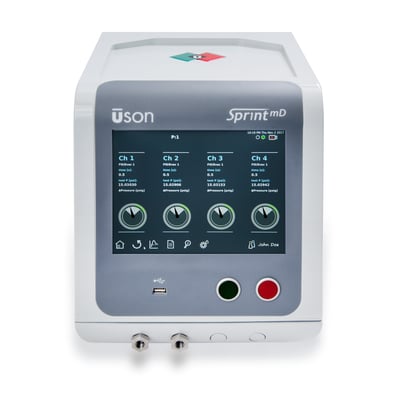Catheter Leak Testing
Uson offers equipment and solutions for effective catheter leak testing using our Sprint mD multi-function leak and flow tester.
Well plate leak testing is a critical part of the manufacturing process to prevent faulty wells that could induce contamination and produce incorrect test results. Well plates, also known as reaction trays or cell culture plates, are used in analytical science research and clinical diagnostic testing laboratories for filtration, separation, optical detection, storage, reaction mixing, cell culture and detection of antimicrobial activity. Well plates are manufactured from a variety of materials including polystyrene, polypropylene, polycarbonate and glass in many shapes and sizes.

Historically, well plates were leak tested using a destructive blue dye test where the part is sealed, placed under water and connected to a 500-mbar vacuum. At the conclusion of the test, the part is inspected. If any blue dye is inside the part, the part has failed, and the batch rejected.
Although a blue dye test can effectively detect leaks, it is a destructive test method, that is slow and not easily scalable. Additionally, the test method is limited to 20 microns which is the smallest diameter hole a water molecule can pass through, and typically a 4 cc air leak.
Due to the massive increase and demand for diagnostics testing kits, it is imperative that every part of the production cycle work without a glitch, where production can scale without compromising quality.
Developing a blue dye test correlation to meet a lower specification requirement, improving operational efficiency by reducing cycle times, and minimizing risk of contamination by identifying bad parts before they make it to the field.

Sprint mD tester configured for 4 channel concurrent non- destructive pressure decay leak test. The Sprint mD’s low internal volume and high sensitivity made it the perfect solution for the well plate application. Its’ 1 cc leak limit allows the tester to capture leaks from smaller molecule liquids. Uson’s Applications Team configured a non-destructive Pressure Decay leak test and test fixture capable of detecting approximately a 4 cc/min air leak at 5 psi. To meet aggressive cycle time requirements, the Sprint mD was configured with 4 test ports so that 4 parts could be tested concurrently.
Uson offers equipment and solutions for effective catheter leak testing using our Sprint mD multi-function leak and flow tester.
Uson offers medical device leak testing solutions for testing breathing tubes and CPAP tubes using our Optima vT leak and flow tester.
Uson's Sprint iQ leak tester is the only off-the-shelf answer to effective fast-flush drug delivery device leak testing
Industries
.jpg)